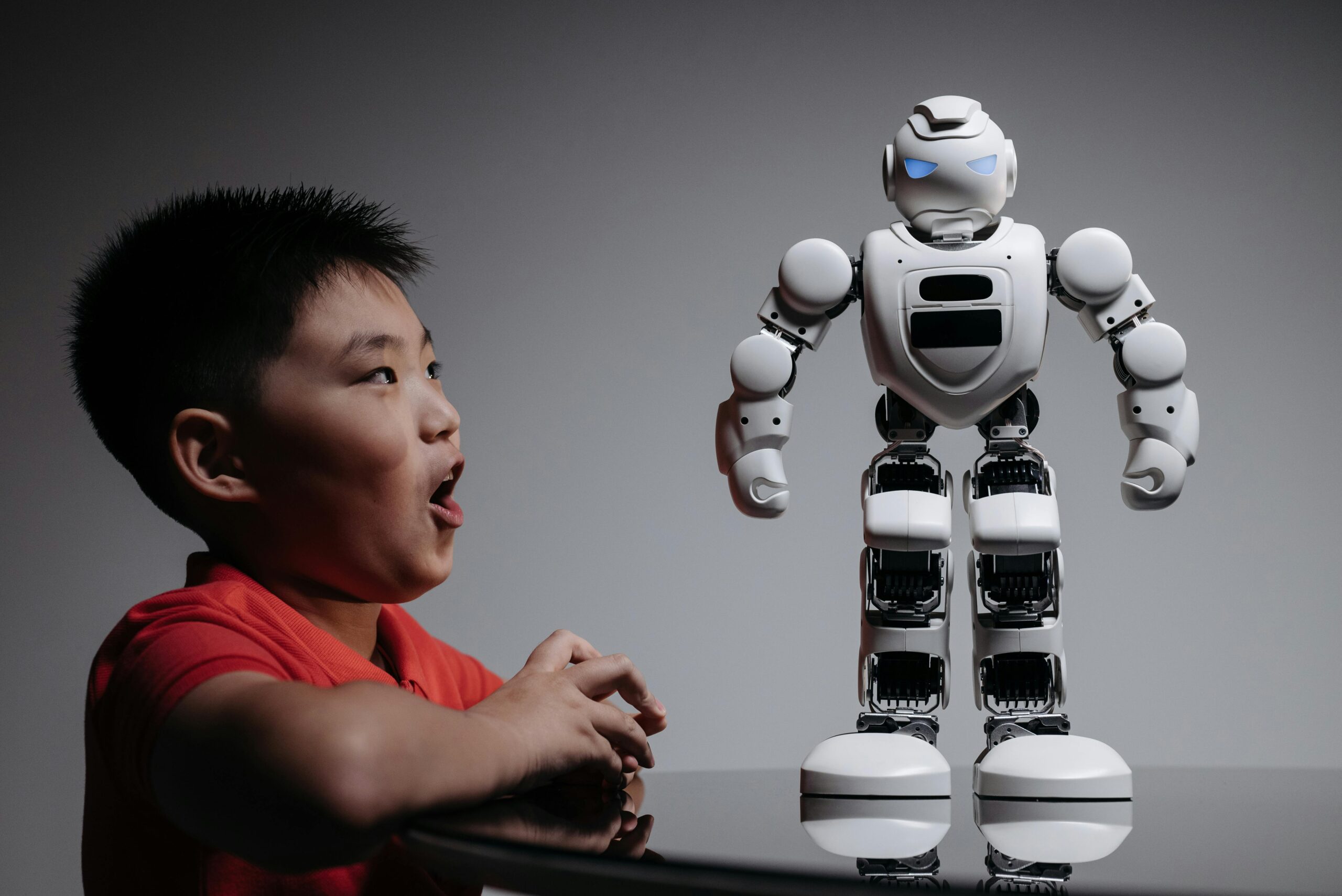Emotion-aware robotics is transforming how machines understand and respond to human feelings, creating unprecedented opportunities for meaningful interaction across healthcare, education, and daily life.
🤖 The Dawn of Emotionally Intelligent Machines
For decades, robots have been confined to performing repetitive tasks in controlled environments, lacking the nuanced understanding that makes human interaction rich and meaningful. Today, we stand at the threshold of a revolutionary era where robots can detect, interpret, and respond to human emotions with remarkable accuracy. This technological leap isn’t just about making machines smarter—it’s about making them more human-aware, capable of reading facial expressions, vocal tones, body language, and even physiological signals to gauge emotional states.
The integration of emotion recognition technology into robotics represents one of the most significant advances in human-computer interaction. By leveraging artificial intelligence, machine learning algorithms, and advanced sensor technologies, emotion-aware robots can now navigate the complex landscape of human feelings, adapting their responses to provide contextually appropriate interactions that feel natural rather than mechanical.
Understanding the Technology Behind Emotional Recognition
Emotion-aware robotics relies on a sophisticated combination of technologies working in concert to decode the subtle signals humans transmit through various channels. At its core, this system integrates computer vision, natural language processing, and sensor fusion to create a comprehensive emotional profile of the person interacting with the robot.
Computer Vision and Facial Expression Analysis 📸
Modern emotion-aware robots employ advanced computer vision systems that can identify and classify facial expressions with accuracy rivaling human observers. These systems analyze facial action units—specific muscle movements that correspond to different emotions—using convolutional neural networks trained on vast datasets of human expressions. The technology can distinguish between genuine and masked emotions, detecting micro-expressions that last mere fractions of a second but reveal authentic emotional states.
High-resolution cameras capture facial features in real-time, while sophisticated algorithms map these features to emotional categories such as happiness, sadness, anger, fear, surprise, and disgust. More advanced systems can even detect complex emotional states like confusion, frustration, or contentment that don’t fit neatly into basic categories.
Voice and Speech Pattern Recognition
Beyond facial expressions, emotion-aware robots analyze vocal characteristics that betray emotional states. Pitch, tempo, volume, and speech patterns all carry emotional information that humans naturally process but machines must be explicitly taught to recognize. Advanced audio processing algorithms examine prosodic features—the rhythm, stress, and intonation of speech—to infer emotional content independent of the actual words spoken.
This capability proves especially valuable when facial expressions are obscured or when interacting with individuals who may have limited facial mobility. The combination of vocal analysis with other modalities creates a more robust and reliable emotional assessment system.
Real-World Applications Transforming Industries
The practical applications of emotion-aware robotics extend far beyond theoretical possibilities, already making tangible impacts across multiple sectors. These implementations demonstrate how emotionally intelligent machines can enhance human experiences and improve outcomes in critical areas.
Healthcare and Therapeutic Interventions 🏥
In healthcare settings, emotion-aware robots are revolutionizing patient care and therapeutic interventions. Robots designed for elderly care can detect signs of depression, loneliness, or distress by monitoring emotional patterns over time, alerting caregivers to potential problems before they escalate. These robots provide companionship while respecting the dignity and autonomy of patients, adjusting their interaction style based on the individual’s emotional state.
For children with autism spectrum disorders, emotion-aware robots serve as invaluable therapeutic tools. These robots can present simplified, consistent emotional expressions that help children learn to recognize and interpret emotions in a non-threatening environment. The robots’ patience and predictability create a safe space for practicing social interactions without the anxiety that human interactions might provoke.
Mental health applications represent another promising frontier. Robots capable of detecting subtle emotional changes can support therapy sessions, providing therapists with objective data about patient emotional responses. Some systems can even conduct preliminary mental health screenings, identifying individuals who might benefit from professional intervention.
Educational Enhancement and Personalized Learning
Emotion-aware educational robots are transforming traditional learning environments by providing personalized instruction that adapts to students’ emotional states. When a student shows signs of frustration or confusion, the robot can modify its teaching approach, offer encouragement, or suggest a break. Conversely, when detecting boredom, the robot might introduce more challenging material or interactive activities.
These adaptive systems have shown promising results in maintaining student engagement and improving learning outcomes. By recognizing emotional cues, educational robots create more supportive learning environments where students feel understood and supported, reducing anxiety associated with learning new concepts.
Customer Service and Hospitality Revolution
The customer service industry is being transformed by emotion-aware robots capable of gauging customer satisfaction and adjusting their service accordingly. In hotels, restaurants, and retail environments, these robots can detect frustration or dissatisfaction early, allowing for proactive service recovery before negative experiences escalate.
Emotion-aware reception robots can greet guests with appropriate warmth, recognize returning customers, and tailor their interaction style to match individual preferences. This personalization creates more memorable experiences and builds stronger customer relationships.
The Psychological Dimensions of Human-Robot Bonding 💭
As robots become more emotionally perceptive, they trigger complex psychological responses in humans. Research reveals that people naturally anthropomorphize robots that display emotional awareness, attributing greater intelligence, trustworthiness, and social presence to machines that seem to “understand” them emotionally.
This anthropomorphization serves as both an asset and a challenge. On one hand, it facilitates more natural interactions and increases user acceptance of robotic assistants. People are more likely to engage with, confide in, and cooperate with robots that demonstrate emotional intelligence. Studies show that patients are more compliant with rehabilitation robots that acknowledge their discomfort and offer encouragement.
However, this tendency also raises ethical questions about appropriate boundaries in human-robot relationships. As robots become more convincing in their emotional displays, there’s risk of users developing unhealthy attachments or being manipulated by emotionally sophisticated machines. Designers must carefully consider how to create emotionally aware robots that support human wellbeing without exploiting emotional vulnerabilities.
Technical Challenges and Limitations
Despite remarkable progress, emotion-aware robotics faces significant technical hurdles that researchers continue to address. Understanding these challenges provides important context for realistic expectations about current capabilities and future developments.
Cultural and Individual Variation in Emotional Expression
Emotional expression varies significantly across cultures and individuals, creating challenges for universal emotion recognition systems. A gesture or expression considered friendly in one culture might be perceived as aggressive in another. Introverts and extroverts display emotions differently, and neurodivergent individuals may have unique expression patterns that standard algorithms struggle to interpret.
Addressing this diversity requires training emotion recognition systems on datasets representing wide demographic and cultural variation. Adaptive systems that learn individual users’ emotional patterns over time offer one promising approach, but achieving true universality remains an ongoing challenge.
Contextual Understanding and Ambiguity
Emotions rarely exist in isolation—they’re embedded in complex social contexts that profoundly influence their meaning. A smile might indicate happiness, politeness, nervousness, or even sarcasm depending on context. Current emotion recognition systems often struggle with this ambiguity, sometimes misinterpreting emotional signals by failing to account for situational factors.
Advanced systems are beginning to incorporate contextual awareness, considering factors like the nature of the interaction, recent conversation history, and environmental conditions. However, achieving human-level contextual understanding remains a distant goal requiring advances in general artificial intelligence.
Ethical Considerations and Privacy Concerns 🔒
The proliferation of emotion-aware robotics raises profound ethical questions that society must address thoughtfully. These concerns span privacy, consent, manipulation potential, and the fundamental nature of human dignity in an age of emotionally perceptive machines.
Emotional Privacy and Data Security
Emotion recognition systems collect highly personal data about individuals’ psychological states. This information could potentially be misused for manipulation, discrimination, or surveillance. Imagine employers using emotion-aware robots to monitor worker morale, or marketers exploiting emotional vulnerabilities detected by service robots.
Robust data protection frameworks must ensure that emotional data receives appropriate safeguards. Users should have clear control over how their emotional information is collected, stored, and used. Transparency about emotion recognition capabilities and explicit consent mechanisms are essential components of ethical implementation.
Authenticity and Emotional Manipulation
As robots become more adept at simulating emotional responses, questions arise about authenticity and manipulation. Should robots be designed to express emotions they don’t genuinely experience? When is it appropriate for a robot to use emotional appeals to influence human behavior?
These questions become particularly acute in vulnerable populations. Children, elderly individuals, and those with cognitive impairments may be especially susceptible to emotional manipulation by convincing robotic systems. Ethical guidelines must establish clear boundaries for acceptable emotional influence while preserving the beneficial aspects of emotionally aware interaction.
Future Horizons: What Lies Ahead for Emotion-Aware Robotics 🚀
The trajectory of emotion-aware robotics points toward increasingly sophisticated and seamlessly integrated systems that become natural extensions of human social environments. Several emerging trends suggest the direction of future development.
Multimodal Integration and Holistic Understanding
Next-generation emotion-aware robots will integrate multiple sensing modalities to create comprehensive emotional profiles. Beyond facial expressions and voice, these systems will incorporate physiological signals like heart rate, skin conductance, and body temperature captured through non-invasive sensors. Gait analysis, posture detection, and gesture recognition will add additional layers of emotional insight.
This holistic approach will dramatically improve accuracy and reliability, reducing the misinterpretations that plague single-modality systems. The integration of these diverse data streams through advanced machine learning will enable robots to understand not just momentary emotional states but sustained moods and even predict emotional transitions.
Emotional Intelligence as a Service
Cloud-based emotion recognition services will democratize access to sophisticated emotional intelligence capabilities, allowing developers to integrate emotion awareness into diverse applications without requiring specialized expertise. This “emotion intelligence as a service” model will accelerate adoption across industries and spawn innovative applications not yet imagined.
However, this centralization also concentrates emotional data in ways that amplify privacy concerns, necessitating careful regulatory frameworks and industry standards to prevent abuse.
Bidirectional Emotional Communication
Future robots won’t merely recognize human emotions—they’ll communicate their own internal states in ways humans intuitively understand. Through sophisticated facial displays, vocal modulation, body language, and even haptic feedback, robots will convey their operational status, confidence levels, and limitations using emotional language.
This bidirectional emotional communication will create more transparent and trustworthy human-robot partnerships where both parties understand each other’s capabilities and constraints, leading to more effective collaboration.
Building Trust Through Emotional Transparency
As emotion-aware robots become more prevalent, establishing and maintaining trust emerges as a critical success factor. Unlike traditional machines whose trustworthiness depends primarily on reliability and accuracy, emotionally intelligent robots must also earn social trust—confidence that they will use their emotional insights appropriately and in users’ best interests.
Transparency about capabilities and limitations helps build this trust. Robots should clearly communicate when they’re analyzing emotions, what conclusions they’re drawing, and how that information influences their behavior. When uncertainty exists about emotional interpretation, robots should acknowledge that ambiguity rather than projecting false confidence.
Designing robots that respect emotional boundaries also proves essential. Just as socially competent humans know when emotional topics are unwelcome or when to give someone space, emotion-aware robots must demonstrate similar social intelligence, recognizing when their emotional awareness might feel intrusive and adjusting accordingly.
Empowering Human Connection Rather Than Replacing It 🤝
Perhaps the most important consideration in developing emotion-aware robotics is ensuring these technologies augment rather than replace human connection. At their best, emotionally intelligent robots should enhance human flourishing by providing support where human resources are scarce, assisting rather than substituting for human caregivers, teachers, and service providers.
The goal isn’t to create robots that make humans obsolete in emotional labor but rather to extend human capacity to care, teach, and serve. An emotion-aware eldercare robot doesn’t replace family visits—it provides companionship and monitoring between those visits, alerting family members to changes that warrant attention and providing consistent support that busy family members struggle to deliver.
Similarly, educational robots don’t eliminate teachers but rather enable more personalized attention for each student by handling routine instruction and freeing educators to focus on complex interpersonal guidance that requires human judgment and creativity.

The Path Forward: Responsible Innovation in Emotional AI
Realizing the transformative potential of emotion-aware robotics while avoiding pitfalls requires collaborative effort among technologists, ethicists, policymakers, and the public. Responsible innovation in this domain demands ongoing dialogue about appropriate applications, necessary safeguards, and societal values we wish to preserve as machines become more emotionally perceptive.
Industry standards and best practices must evolve alongside technology, establishing guidelines for data handling, consent procedures, transparency requirements, and accountability mechanisms. Academic research should continue exploring not just technical capabilities but also psychological impacts and societal implications of widespread emotion-aware robot deployment.
Public education about emotion recognition technology will help individuals make informed decisions about accepting or declining emotionally aware services. Just as we’ve developed social literacy around social media and smartphones, we need emotional AI literacy that empowers people to engage with these technologies on their own terms.
The revolution in human-robot interaction driven by emotion-aware capabilities represents one of the defining technological transitions of our era. By proceeding thoughtfully, prioritizing human wellbeing, and maintaining focus on augmenting rather than replacing human connection, we can harness this powerful technology to create a future where machines serve not just our practical needs but also recognize and respect our emotional humanity. The robots of tomorrow won’t just work alongside us—they’ll understand us in ways that make collaboration more natural, effective, and ultimately more humane.
Toni Santos is a digital culture researcher and emotional technology writer exploring how artificial intelligence, empathy, and design shape the future of human connection. Through his studies on emotional computing, digital wellbeing, and affective design, Toni examines how machines can become mirrors that reflect — and refine — our emotional intelligence. Passionate about ethical technology and the psychology of connection, Toni focuses on how mindful design can nurture presence, compassion, and balance in the digital age. His work highlights how emotional awareness can coexist with innovation, guiding a future where human sensitivity defines progress. Blending cognitive science, human–computer interaction, and contemplative psychology, Toni writes about the emotional layers of digital life — helping readers understand how technology can feel, listen, and heal. His work is a tribute to: The emotional dimension of technological design The balance between innovation and human sensitivity The vision of AI as a partner in empathy and wellbeing Whether you are a designer, technologist, or conscious creator, Toni Santos invites you to explore the new frontier of emotional intelligence — where technology learns to care.




